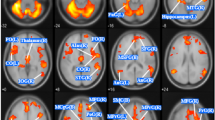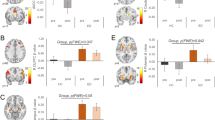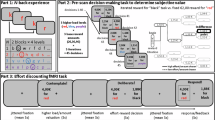Abstract
Anorexia nervosa (AN) is a severe psychiatric disorder associated with food avoidance and malnutrition. In this study, we wanted to test whether we would find brain reward alterations in AN, compared with individuals with normal or increased body weight. We studied 21 underweight, restricting-type AN (age M 22.5, SD 5.8 years), 19 obese (age M 27.1, SD 6.7 years), and 23 healthy control women (age M 24.8, SD 5.6 years), using blood oxygen level-dependent functional magnetic resonance brain imaging together with a reward-conditioning task. This paradigm involves learning the association between conditioned visual stimuli and unconditioned taste stimuli, as well as the unexpected violation of those learned associations. The task has been associated with activation of brain dopamine reward circuits, and it allows the comparison of actual brain response with expected brain activation based on established neuronal models. A group-by-task condition analysis (family-wise-error-corrected P<0.05) indicated that the orbitofrontal cortex differentiated all three groups. The dopamine model reward-learning signal distinguished groups in the anteroventral striatum, insula, and prefrontal cortex (P<0.001, 25 voxel cluster threshold), with brain responses that were greater in the AN group, but lesser in the obese group, compared with controls. These results suggest that brain reward circuits are more responsive to food stimuli in AN, but less responsive in obese women. The mechanism for this association is uncertain, but these brain reward response patterns could be biomarkers for the respective weight state.
Similar content being viewed by others
Log in or create a free account to read this content
Gain free access to this article, as well as selected content from this journal and more on nature.com
or
References
American Psychiatric Association (2000). Diagnostic and Statistical Manual of Mental Disorders - Text Revision (DSM-IV-TR). Handbook of Psychiatric Measures. American Psychiatric Association: Washington DC.
Anderson JW, Greenway FL, Fujioka K, Gadde KM, McKenney J, O’Neil PM (2002). Bupropion SR enhances weight loss: a 48-week double-blind, placebo- controlled trial. Obes Res 10: 633–641.
Avena NM, Rada P, Hoebel BG (2008). Underweight rats have enhanced dopamine release and blunted acetylcholine response in the nucleus accumbens while bingeing on sucrose. Neuroscience 156: 865–871.
Bailer UF, Frank GK, Henry SE, Price JC, Meltzer CC, Mathis CA et al (2007). Exaggerated 5-HT1A but normal 5-HT2A receptor activity in individuals ill with anorexia nervosa. Biol Psychiatry 61: 1090–1099.
Barbato G, Fichele M, Senatore I, Casiello M, Muscettola G (2006). Increased dopaminergic activity in restricting-type anorexia nervosa. Psychiatry Res 142: 253–255.
Beck AT, Ward M, Mendelson M, Mock J, Erbaugh J (1961). An Inventory for measuring depression. Arch Gen Psychiatry 4: 53–63.
Berridge KC (2009). Liking’ and ‘wanting’ food rewards: brain substrates and roles in eating disorders. Physiol Behav 97: 537–550.
Berridge KC, Ho CY, Richard JM, DiFeliceantonio AG (2010). The tempted brain eats: pleasure and desire circuits in obesity and eating disorders. Brain Res 1350: 43–64.
Boettiger CA, Mitchell JM, Tavares VC, Robertson M, Joslyn G, D’Esposito M et al (2007). Immediate reward bias in humans: fronto-parietal networks and a role for the catechol-O-methyltransferase 158(Val/Val) genotype. J Neurosci 27: 14383–14391.
Carmichael ST, Price JL (1996). Connectional networks within the orbital and medial prefrontal cortex of macaque monkeys. J Comp Neurol 371: 179–207.
Carr K, Tsimberg Y, Berman Y, Yamamoto N (2003). Evidence of increased dopamine receptor signaling in food-restricted rats. Neuroscience 119: 1157–1167.
Carr KD (2002). Augmentation of drug reward by chronic food restriction: behavioral evidence and underlying mechanisms. Physiol Behav 76: 353–364.
Carr KD (2007). Chronic food restriction: enhancing effects on drug reward and striatal cell signaling. Physiol Behav 91: 459–472.
Cassano G, Miniati M, Pini S, Rotondo A, Banti S, Borri C et al (2003). Six-month open trial of haloperidol as an adjunctive treatment for anorexia nervosa: a preliminary report. Int J Eat Disord 33: 172–177.
Cloninger C, Przybeck T, Svarkic D, Wetzel R (1994). The Temperament and Character Inventory (TCI): A Guide to Its Development and Use. Center for Psychobiology of Personality, Washington University: St. Louis, MO.
Corsica JA, Pelchat ML (2010). Food addiction: true or false? Curr Opin Gastroenterol 26: 165–169.
Cowdrey FA, Park RJ, Harmer CJ, McCabe C (2011). Increased neural processing of rewarding and aversive food stimuli in recovered anorexia nervosa. Biol Psychiatry 70: 736–743.
D’Ardenne K, McClure SM, Nystrom LE, Cohen JD (2008). BOLD responses reflecting dopaminergic signals in the human ventral tegmental area. Science 319: 1264–1267.
Davis C, Levitan RD, Kaplan AS, Carter J, Reid C, Curtis C et al (2007). Dopamine transporter gene (DAT1) associated with appetite suppression to methylphenidate in a case-control study of binge eating disorder. Neuropsychopharmacology 32: 2199–2206.
Daw ND, Doya K (2006). The computational neurobiology of learning and reward. Curr Opin Neurobiol 16: 199–204.
Daw ND, Gershman SJ, Seymour B, Dayan P, Dolan RJ (2011). Model-based influences on humans’ choices and striatal prediction errors. Neuron 69: 1204–1215.
de Araujo IE, Ren X, Ferreira JG (2010). Metabolic sensing in brain dopamine systems. Results Probl Cell Differ 52: 69–86.
Dreher JC, Meyer-Lindenberg A, Kohn P, Berman KF (2008). Age-related changes in midbrain dopaminergic regulation of the human reward system. Proc Natl Acad Sci USA 105: 15106–15111.
Dreher JC, Schmidt PJ, Kohn P, Furman D, Rubinow D, Berman KF (2007). Menstrual cycle phase modulates reward-related neural function in women. Proc Natl Acad Sci USA 104: 2465–2470.
Elliott R, Dolan RJ, Frith CD (2000). Dissociable functions in the medial and lateral orbitofrontal cortex: evidence from human neuroimaging studies. Cereb Cortex 10: 308–317.
Felsted JA, Ren X, Chouinard-Decorte F, Small DM (2010). Genetically determined differences in brain response to a primary food reward. J Neurosci 30: 2428–2432.
Fladung AK, Gron G, Grammer K, Herrnberger B, Schilly E, Grasteit S et al (2010). A neural signature of anorexia nervosa in the ventral striatal reward system. Am J Psychiatry 167: 206–212.
Frank GK, Bailer UF, Henry SE, Drevets W, Meltzer CC, Price JC et al (2005). Increased dopamine D2/D3 receptor binding after recovery from anorexia nervosa measured by positron emission tomography and [11c]raclopride. Biol Psychiatry 58: 908–912.
Frank GK, Reynolds JR, Shott ME, O’Reilly RC (2011). Altered temporal difference learning in bulimia nervosa. Biol Psychiatry 70: 728–735.
Garner D (2004). Eating Disorder Inventory™-3 (EDI™-3). Psychological Assessment Resources, Inc.: Lutz, FL.
Gearhardt AN, Yokum S, Orr PT, Stice E, Corbin WR, Brownell KD (2011). Neural correlates of food addiction. Arch Gen Psychiatry 68: 808–816.
Goldfield GS, Lorello C, Doucet E (2007). Methylphenidate reduces energy intake and dietary fat intake in adults: a mechanism of reduced reinforcing value of food? Am J Clin Nutr 86: 308–315.
Goldstein RZ, Tomasi D, Alia-Klein N, Cottone LA, Zhang L, Telang F et al (2007). Subjective sensitivity to monetary gradients is associated with frontolimbic activation to reward in cocaine abusers. Drug Alcohol Depend 87: 233–240.
Gunstad J, Paul RH, Cohen RA, Tate DF, Spitznagel MB, Grieve S et al (2008). Relationship between body mass index and brain volume in healthy adults. Int J Neurosci 118: 1582–1593.
Halmi KA (2009). Perplexities and provocations of eating disorders. J Child Psychol Psychiatry 50: 163–169.
Hazy TE, Frank MJ, O’Reilly RC (2010). Neural mechanisms of acquired phasic dopamine responses in learning. Neurosci Biobehav Rev 34: 701–720.
Hyman SE, Malenka RC (2001). Addiction and the brain: the neurobiology of compulsion and its persistence. Nat Rev Neurosci 2: 695–703.
Jocham G, Klein TA, Ullsperger M (2011). Dopamine-mediated reinforcement learning signals in the striatum and ventromedial prefrontal cortex underlie value-based choices. J Neurosci 31: 1606–1613.
Johnson PM, Kenny PJ (2010). Dopamine D2 receptors in addiction-like reward dysfunction and compulsive eating in obese rats. Nat Neurosci 13: 635–641.
Karson CN (1983). Spontaneous eye-blink rates and dopaminergic systems. Brain J Neurol 106: 643–653.
Kaye WH, Ebert MH, Raleigh M, Lake R (1984). Abnormalities in CNS monoamine metabolism in anorexia nervosa. Arch Gen Psychiatry 41: 350–355.
Kaye WH, Fudge JL, Paulus M (2009). New insights into symptoms and neurocircuit function of anorexia nervosa. Nat Rev Neurosci 10: 573–584.
Kelley AE, Baldo BA, Pratt WE, Will MJ (2005). Corticostriatal-hypothalamic circuitry and food motivation: integration of energy, action and reward. Physiol Behav 86: 773–795.
Koob GF, Le Moal M (2005). Plasticity of reward neurocircuitry and the ‘dark side’ of drug addiction. Nat Neurosci 8: 1442–1444.
Kumar P, Waiter G, Ahearn T, Milders M, Reid I, Steele JD (2008). Abnormal temporal difference reward-learning signals in major depression. Brain 131: 2084–2093.
Kuruoglu AC, Kapucu O, Atasever T, Arikan Z, Isik E, Unlu M (1998). Technetium-99m-HMPAO brain SPECT in anorexia nervosa. J Nucl Med 39: 304–306.
Maia TV, Frank MJ (2011). From reinforcement learning models to psychiatric and neurological disorders. Nat Neurosci 14: 154–162.
Menon M, Jensen J, Vitcu I, Graff-Guerrero A, Crawley A, Smith MA et al (2007). Temporal difference modeling of the blood-oxygen level dependent response during aversive conditioning in humans: effects of dopaminergic modulation. Biol Psychiatry 62: 765–772.
Noonan MP, Walton ME, Behrens TE, Sallet J, Buckley MJ, Rushworth MF (2010). Separate value comparison and learning mechanisms in macaque medial and lateral orbitofrontal cortex. Proc Natl Acad Sci USA 107: 20547–20552.
O’Connor R, Colder C, Hawk L (2004). Confirmatory factor analysis of the Sensitivity to Punishment and Sensitivity to Reward Questionnaire. Pers Indiv Differ 37: 985–1002.
O’Doherty JP, Dayan P, Friston K, Critchley H, Dolan RJ (2003). Temporal difference models and reward-related learning in the human brain. Neuron 38: 329–337.
Rastam M, Bjure J, Vestergren E, Uvebrant P, Gillberg IC, Wentz E et al (2001). Regional cerebral blood flow in weight-restored anorexia nervosa: a preliminary study. Dev Med Child Neurol 43: 239–242.
Schultz W (1998). Predictive reward signal of dopamine neurons. J Neurophysiol 80: 1–27.
Schultz W (2002). Getting formal with dopamine and reward. Neuron 36: 241–263.
Schultz W, Dayan P, Montague PR (1997). A neural substrate of prediction and reward. Science 275: 1593–1599.
Small DM, Zatorre RJ, Dagher A, Evans AC, Jones-Gotman M (2001). Changes in brain activity related to eating chocolate: from pleasure to aversion. Brain 124: 1720–1733.
Spielberger CD (1983). Manual for the State-Trate Anxiety Inventory. Consulting Psychologists Press, Inc.: Palo Alto, CA.
Stice E, Yokum S, Blum K, Bohon C (2010). Weight gain is associated with reduced striatal response to palatable food. J Neurosci 30: 13105–13109.
Stoy M, Schlagenhauf F, Sterzer P, Bermpohl F, Hagele C, Suchotzki K et al (2011). Hyporeactivity of ventral striatum towards incentive stimuli in unmedicated depressed patients normalizes after treatment with escitalopram. J Psychopharmacol; e-pub ahead of print 17 September 2011.
Sutton RS, Barto AG (1998). Toward a Modern Theory of Adaptive Networks: Expectation and Prediction. MIT Press: Boston, MA.
Thirion B, Pinel P, Meriaux S, Roche A, Dehaene S, Poline JB (2007). Analysis of a large fMRI cohort: statistical and methodological issues for group analyses. Neuroimage 35: 105–120.
Trunko ME, Schwartz TA, Duvvuri V, Kaye WH (2011). Aripiprazole in anorexia nervosa and low-weight bulimia nervosa: case reports. Int J Eat Disord 44: 269–275.
Tsujimoto S, Genovesio A, Wise SP (2009). Monkey orbitofrontal cortex encodes response choices near feedback time. J Neurosci 29: 2569–2574.
Volkow ND, Tomasi D, Wang GJ, Fowler JS, Telang F, Goldstein RZ et al (2011). Positive emotionality is associated with baseline metabolism in orbitofrontal cortex and in regions of the default network. Mol Psychiatry 16: 818–825.
Volkow ND, Wang GJ, Telang F, Fowler JS, Thanos PK, Logan J et al (2008). Low dopamine striatal D2 receptors are associated with prefrontal metabolism in obese subjects: possible contributing factors. Neuroimage 42: 1537–1543.
Wagner A, Aizenstein H, Mazurkewicz L, Fudge J, Frank GK, Putnam K et al (2008). Altered insula response to taste stimuli in individuals recovered from restricting-type anorexia nervosa. Neuropsychopharmacology 33: 513–523.
Wagner A, Aizenstein H, Venkatraman VK, Fudge J, May JC, Mazurkewicz L et al (2007). Altered reward processing in women recovered from anorexia nervosa. Am J Psychiatry 164: 1842–1849.
Waltz JA, Schweitzer JB, Ross TJ, Kurup PK, Salmeron BJ, Rose EJ et al (2010). Abnormal responses to monetary outcomes in cortex, but not in the basal ganglia, in schizophrenia. Neuropsychopharmacology 35: 2427–2439.
Willeumier KC, Taylor DV, Amen DG (2011). Elevated BMI is associated with decreased blood flow in the prefrontal cortex using SPECT imaging in healthy adults. Obesity 19: 1095–1097.
Acknowledgements
We thank Dr O’Doherty for providing the fractal images used as CS in the study. We would like to thank all the individuals who participated in this study, as well as the staff at the Eating Disorders program at the Children's Hospital and the Eating Disorder Center Denver.
Author information
Authors and Affiliations
Corresponding author
Ethics declarations
Competing interests
The authors declare no conflict of interest. All authors contributed significantly to this manuscript. Dr Frank is on the scientific advisory board of the Eating Disorders Center of Denver. Dr O’Reilly has received funding through the NIH IBSC center Grant 1-P50-MH079485. A Davis Foundation Award of the Klarman Family Foundation Grants Program in Eating Disorders, and the NIMH Grant K23 MH080135-01A2 provided funding for all aspects of the study to Dr Frank. The following is a list of the funding sources for each of the contributing authors: Dr Frank: NIH 5K23MH080135-04; Dr Reynolds: NIH, MH 079485, P50/IBSC and NIH, R01-DA027748; Dr O’Reilly: iARPA, ICArUS MINDS, NIH IBSC center 1-P50-MH079485 and ONR N00014-10-1-0177 1/15/10-12/31/12; Dr Yang: NIH 5R01MH085734-02; Dr Tregellas: VA 1I01CX000459-01 and NIH 5R01DK089095-02; Ms Shott And Ms Jappe: not applicable.
Additional information
Supplementary Information accompanies the paper on the Neuropsychopharmacology website
Supplementary information
PowerPoint slides
Rights and permissions
About this article
Cite this article
Frank, G., Reynolds, J., Shott, M. et al. Anorexia Nervosa and Obesity are Associated with Opposite Brain Reward Response. Neuropsychopharmacol 37, 2031–2046 (2012). https://doi.org/10.1038/npp.2012.51
Received:
Revised:
Accepted:
Published:
Issue date:
DOI: https://doi.org/10.1038/npp.2012.51
Keywords
This article is cited by
-
Neural effects of deep brain stimulation on reward and loss anticipation and food viewing in anorexia nervosa: a pilot study
Journal of Eating Disorders (2023)
-
Neural activation of regions involved in food reward and cognitive control in young females with anorexia nervosa and atypical anorexia nervosa versus healthy controls
Translational Psychiatry (2023)
-
Anorexia nervosa as a disorder of the subcortical–cortical interoceptive-self
Eating and Weight Disorders - Studies on Anorexia, Bulimia and Obesity (2022)
-
Obesity-induced taste dysfunction, and its implications for dietary intake
International Journal of Obesity (2021)
-
Study protocol of a randomised controlled feasibility study of food-related computerised attention training versus mindfulness training and waiting-list control for adults with overweight or obesity
Trials (2020)



